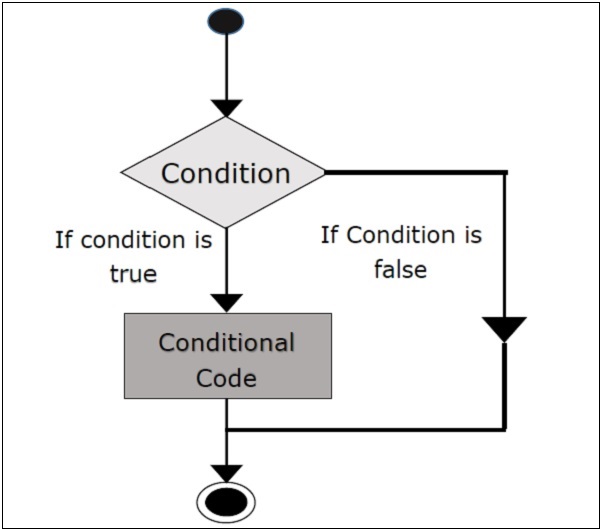- C++ 中的 if else(1)
- if else c++ (1)
- C# if-else(1)
- c# if else - C# (1)
- if else c#(1)
- c# if else (1)
- C++ if-else
- C++ if-else(1)
- c++ if else - C++ (1)
- C# if-else
- if else python(1)
- python中的短if else(1)
- else if python (1)
- if else python(1)
- c++ if else - C++ 代码示例
- if else c#代码示例
- if else c++ 代码示例
- C++ 代码示例中的 if else
- c# if else - C# 代码示例
- if else javascript (1)
- else if javascript (1)
- if else java(1)
- java if-else(1)
- java if-else
- Arduino if-else和else-if(1)
- Arduino if-else和else-if
- php之if-else(1)
- php之if-else
- if else python代码示例
📅 最后修改于: 2020-11-02 04:43:37 🧑 作者: Mango
本章将引导您完成Scala编程中的条件构造语句。以下是大多数编程语言中常见的IF … ELSE决策结构的一般形式。
流程图
以下是条件语句的流程图。

如果声明
“ if”语句由一个布尔表达式和一个或多个语句组成。
句法
“ if”语句的语法如下。
if(Boolean_expression) {
// Statements will execute if the Boolean expression is true
}
如果布尔表达式的计算结果为true,则将执行“ if”表达式中的代码块。如果不是,则将执行“ if”表达式结尾之后的第一组代码(在大括号后)。
尝试使用以下示例程序来了解Scala编程语言中的条件表达式(如果是表达式)。
例
object Demo {
def main(args: Array[String]) {
var x = 10;
if( x < 20 ){
println("This is if statement");
}
}
}
将以上程序保存在Demo.scala中。以下命令用于编译和执行该程序。
命令
\>scalac Demo.scala
\>scala Demo
输出
This is if statement
If-else陈述
“ if”语句后可以跟可选的else语句,该语句在布尔表达式为false时执行。
句法
if … else的语法是-
if(Boolean_expression){
//Executes when the Boolean expression is true
} else{
//Executes when the Boolean expression is false
}
尝试以下示例程序以了解Scala编程语言中的条件语句(if- else语句)。
例
object Demo {
def main(args: Array[String]) {
var x = 30;
if( x < 20 ){
println("This is if statement");
} else {
println("This is else statement");
}
}
}
将以上程序保存在Demo.scala中。以下命令用于编译和执行该程序。
命令
\>scalac Demo.scala
\>scala Demo
输出
This is else statement
If-else-if-else语句
‘if’语句后可以是可选的’ else if … else ‘语句,这对于使用单个if … else if语句测试各种条件非常有用。
使用if,else if,else语句时,要牢记几点。
-
“ if”可以有零个或另一个,并且必须在其他if之后。
-
一个“ if”可以有零到多个其他if,并且它们必须排在else之前。
-
如果其他条件成功,则将不会测试其余任何其他条件。
句法
以下是’if … else if … else’的语法如下-
if(Boolean_expression 1){
//Executes when the Boolean expression 1 is true
} else if(Boolean_expression 2){
//Executes when the Boolean expression 2 is true
} else if(Boolean_expression 3){
//Executes when the Boolean expression 3 is true
} else {
//Executes when the none of the above condition is true.
}
尝试使用以下示例程序来了解Scala编程语言中的条件语句(if- else- if- else语句)。
例
object Demo {
def main(args: Array[String]) {
var x = 30;
if( x == 10 ){
println("Value of X is 10");
} else if( x == 20 ){
println("Value of X is 20");
} else if( x == 30 ){
println("Value of X is 30");
} else{
println("This is else statement");
}
}
}
将以上程序保存在Demo.scala中。以下命令用于编译和执行该程序。
命令
\>scalac Demo.scala
\>scala Demo
输出
Value of X is 30
嵌套if-else语句
它始终是合法的窝if-else语句,如果要不-if语句,你可以使用一个if或else-if语句内的另一个该装置。
句法
嵌套if-else的语法如下-
if(Boolean_expression 1){
//Executes when the Boolean expression 1 is true
if(Boolean_expression 2){
//Executes when the Boolean expression 2 is true
}
}
尝试使用以下示例程序来了解Scala编程语言中的条件语句(嵌套if语句)。
例
object Demo {
def main(args: Array[String]) {
var x = 30;
var y = 10;
if( x == 30 ){
if( y == 10 ){
println("X = 30 and Y = 10");
}
}
}
}
将以上程序保存在Demo.scala中。以下命令用于编译和执行该程序。
命令
\>scalac Demo.scala
\>scala Demo
输出
X = 30 and Y = 10